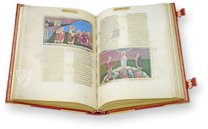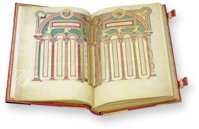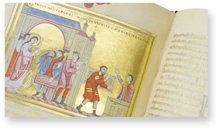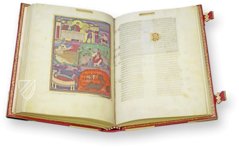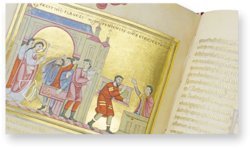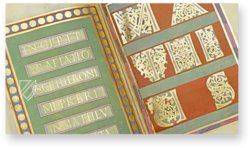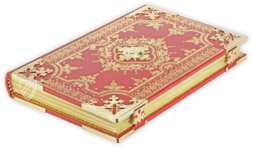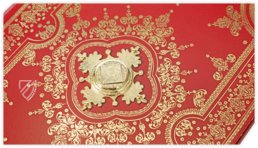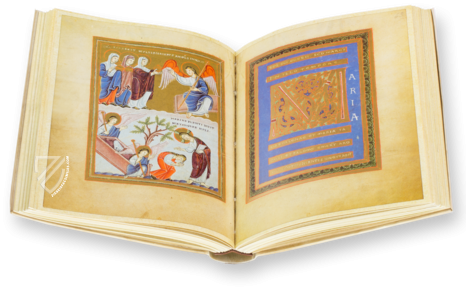Codex Aureus Escorialensis
(over 10,000€)
The Codex Aureus Escorialensis, also known as the Speyer Gospels, the Golden Gospels of Henry III or simply as the Liber Vitae, is counted among the most significant manuscripts of Ottonian illumination. The patron of this outstanding document was Henry III, the Holy Roman Emperor from the Salian Dynasty. The Codex Aureus Escorialensis was made in the famous scriptorium of Echternach Abbey. The manuscript, with stately measurements of over 50 x 33 cm, contains exuberant visual adornment consisting of 56 full- and half-page miniatures, splendid vine-covered initials and text continuously written in gold ink! The manuscript carries political significance as a manifestation of Salian rule, but takes center stage nonetheless as an unbelievable gem of 11th century illumination!
Codex Aureus Escorialensis
The Codex Aureus Escorialensis, also known as the Speyer Gospels, the Golden Gospels of Henry III or simply as the Liber Vitae, is counted among the most significant manuscripts of Ottonian illumination. The patron of this outstanding document was Henry III, the Holy Roman Emperor from the Salian Dynasty. The Codex Aureus Escorialensis was made in the famous scriptorium of Echternach Abbey. The manuscript, with stately measurements of over 50 x 33 cm, contains exuberant visual adornment consisting of 56 full- and half-page miniatures, splendid vine-covered initials and text continuously written in gold ink! The manuscript carries political significance as a manifestation of Salian rule, but takes center stage nonetheless as an unbelievable gem of 11th century illumination!
The Golden Gospels of Henry III
Emperor Henry III (1016–1054) from the Salian Dynasty had his famous Golden Gospels, the Codex Aureus Escorialensis, made on the occasion of the consecration of Speyer Cathedral’s high altar. The imperial gift for the Speyer Cathedral, which was meant to manifest Henry’s rule, is considered to be one of the primary works of Ottonian illumination to this day. In addition to the designation Codex Aureus Escorialensis – after its modern repository in the famous library of the royal San Lorenzo de Escorial Monastery – the manuscript bears other titles: Codex Aureus Spirensis (an indication of Speyer as the site it was originally dedicated to), the Salian Imperial Gospels, the Speyer Gospels, and the Golden Gospels of Henry III are all present in research. Henry III himself named the codex Liber Vitae, “Book of Life”.
Grandiose Miniatures and Golden Text
The Codex Aureus Escorialensis is a work from Echternach Abbey. The Ottonian codex was completed in the years 1043–1046 in the famous scriptorium there, where a multitude of significant manuscripts were produced. Seven miniaturists presumably participated in the completion of the codex. The manuscript shows off with 13 full-page and 43 half-page miniatures, in addition to 12 canon tables and 44 decorative pages. Countless vine-covered initials adorn the pages with text written entirely in gold ink! In addition to this interior splendor, its exterior indicates its imperial status: the Codex Aureus Escorialensis has the stately dimensions of 50.7 x 33.5 cm and as a result, it is the “largest medieval evangelary ever created!”!
A Royal History of Ownership
The visual décor of the splendid Ottonian manuscript follows a strict numerical symbolism based on the divine order. Alongside the golden text of the codex, the visual adornment of the document is comprised of thoroughly high-quality illumination. The splendid dedication picture is only an example of this outstanding quality: the Emperor Henry III and his wife Agnes kneel in silent prayer on either side on an enthroned Virgin Mary in the center of the splendid architectural backdrop of the Speyer Cathedral, which had not yet been finished at the time of the codex’s completion! The manuscript came into the possession of Margaret of Austria by way of Maximilian I, then Mary of Hungary, and finally came to Spain through King Philip II. Today, the Codex Aureus Escorialensis is counted among the greatest treasures of the El Escorial Library.
Codicology
- Alternative Titles
- Codex Aureus Escurialensis
Golden Codex
Speyerer Evangeliar
Salisches Kaiserevangeliar
Códice Áureo
Golden Gospels of Henry III
Speyer Gospels
Codex Aureus Spirensis - Size / Format
- 342 pages / 50.7 × 33.5 cm
- Origin
- Luxembourg
- Date
- 1043–1046
- Style
- Genre
- Language
- Script
- Carolingian minuscule
- Illustrations
- 13 full-page and 43 half-page miniatures, 12 canon tables with classical arcades, 44 decorative pages with incipits and large initials, colorful gold leaf frames
- Content
- Gospel Book
- Patron
- Henry III, Holy Roman Emperor (1016–1054)
- Artist / School
- Propably six illuminators
- Previous Owners
- Emperor Maximilian I (1459–1519)
Margaret of Austria (1480–1530)
Mary of Hungary (1505–58)
Philip II, King of Spain and Portugal (reigned 1556–1598)
Codex Aureus Escorialensis
Entry into Jerusalem
Commemorated on Palm Sunday, Christ’s triumphal entry into Jerusalem marks the beginning of the Passion cycle. Christ is depicted riding on a donkey, which symbolizes peace in contrast to a horse. He is followed by a procession of his barefooted disciples and is greeted by the shod citizens of Jerusalem. Some hold palm branches while others lay down their robes. Rather than a typical cityscape of Jerusalem in the background, burnished gold leaf gives the scene a timeless and spaceless feeling.

Codex Aureus Escorialensis
Henry III Presents the Codex to the Virgin Mary
The Mother of God is regally seated in her distinctive blue cloak before a Byzantine-style background of burnished gold that gives the scene a divine effect as though she just appeared upon the throne. Speyer Cathedral, to which this extraordinary manuscript was dedicated, is represented by the Romanesque architecture in the background.
Humbly averting his gaze, Emperor Henry III presents the codex to the Virgin Mary, who simultaneously blesses the Empress Agnes as she kneels in prayer. In the surrounding frame, the king says: "O Queen of Heaven, do not reject me King. By giving this gift, I entrust myself to you, the Father, the Mother, and especially the one to whom I am attached in love of the offspring. May you always be a gracious helper. "

#1 Códice Áureo (Deluxe Edition)
Language: Spanish
(over 10,000€)
#2 Códice Áureo (Standard Edition)
Language: Spanish
(over 10,000€)
- Treatises / Secular Books
- Apocalypses / Beatus
- Astronomy / Astrology
- Bestiaries
- Bibles / Gospels
- Chronicles / History / Law
- Geography / Maps
- Saints' Lives
- Islam / Oriental
- Judaism / Hebrew
- Single Leaf Collections
- Leonardo da Vinci
- Literature / Poetry
- Liturgical Manuscripts
- Medicine / Botany / Alchemy
- Music
- Mythology / Prophecies
- Psalters
- Other Religious Books
- Games / Hunting
- Private Devotion Books
- Other Genres
- Afghanistan
- Armenia
- Austria
- Belgium
- Belize
- Bosnia and Herzegovina
- China
- Colombia
- Costa Rica
- Croatia
- Cyprus
- Czech Republic
- Denmark
- Egypt
- El Salvador
- Ethiopia
- France
- Germany
- Greece
- Guatemala
- Honduras
- Hungary
- India
- Iran
- Iraq
- Israel
- Italy
- Japan
- Jordan
- Kazakhstan
- Kyrgyzstan
- Lebanon
- Liechtenstein
- Luxembourg
- Mexico
- Morocco
- Netherlands
- Palestine
- Panama
- Peru
- Poland
- Portugal
- Romania
- Russia
- Serbia
- Spain
- Sri Lanka
- Sweden
- Switzerland
- Syria
- Tajikistan
- Turkey
- Turkmenistan
- Ukraine
- United Kingdom
- United States
- Uzbekistan
- Vatican City
- A. Oosthoek, van Holkema & Warendorf
- Aboca Museum
- Ajuntament de Valencia
- Akademie Verlag
- Akademische Druck- u. Verlagsanstalt (ADEVA)
- Aldo Ausilio Editore - Bottega d’Erasmo
- Alecto Historical Editions
- Alkuin Verlag
- Almqvist & Wiksell
- Amilcare Pizzi
- Andreas & Andreas Verlagsbuchhandlung
- Archa 90
- Archiv Verlag
- Archivi Edizioni
- Arnold Verlag
- ARS
- Ars Magna
- ArtCodex
- AyN Ediciones
- Azimuth Editions
- Badenia Verlag
- Bärenreiter-Verlag
- Belser Verlag
- Belser Verlag / WK Wertkontor
- Benziger Verlag
- Bernardinum Wydawnictwo
- BiblioGemma
- Biblioteca Apostolica Vaticana (Vaticanstadt, Vaticanstadt)
- Bibliotheca Palatina Faksimile Verlag
- Bibliotheca Rara
- Boydell & Brewer
- Bramante Edizioni
- Bredius Genootschap
- Brepols Publishers
- British Library
- C. Weckesser
- Caixa Catalunya
- Canesi
- CAPSA, Ars Scriptoria
- Caratzas Brothers, Publishers
- Carus Verlag
- Casamassima Libri
- Centrum Cartographie Verlag GmbH
- Chavane Verlag
- Christian Brandstätter Verlag
- Circulo Cientifico
- Club Bibliófilo Versol
- Club du Livre
- CM Editores
- Collegium Graphicum
- Collezione Apocrifa Da Vinci
- Comissão Nacional para as Comemorações dos Descobrimentos Portugueses
- Coron Verlag
- Corvina
- CTHS
- D. S. Brewer
- Damon
- De Agostini/UTET
- De Nederlandsche Boekhandel
- De Schutter
- Deuschle & Stemmle
- Deutscher Verlag für Kunstwissenschaft
- DIAMM
- Droz
- E. Schreiber Graphische Kunstanstalten
- Ediciones Boreal
- Ediciones Grial
- Ediclube
- Edições Inapa
- Edilan
- Editalia
- Edition Deuschle
- Edition Georg Popp
- Edition Leipzig
- Edition Libri Illustri
- Editiones Reales Sitios S. L.
- Éditions de l'Oiseau Lyre
- Editions Medicina Rara
- Editorial Casariego
- Editorial Mintzoa
- Editrice Antenore
- Editrice Velar
- Edizioni Edison
- Egeria, S.L.
- Eikon Editores
- Electa
- Emery Walker Limited
- Enciclopèdia Catalana
- Eos-Verlag
- Ephesus Publishing
- Ernst Battenberg
- Eugrammia Press
- Extraordinary Editions
- Fackelverlag
- Facsimila Art & Edition
- Facsimile Editions Ltd.
- Facsimilia Art & Edition Ebert KG
- Faksimile Verlag
- Feuermann Verlag
- Folger Shakespeare Library
- Franco Cosimo Panini Editore
- Friedrich Wittig Verlag
- Fundación Hullera Vasco-Leonesa
- G. Braziller
- Gabriele Mazzotta Editore
- Gebr. Mann Verlag
- Gesellschaft für graphische Industrie
- Getty Research Institute
- Giovanni Domenico de Rossi
- Giunti Editore
- Graffiti
- Grafica European Center of Fine Arts
- Guido Pressler
- Guillermo Blazquez
- Gustav Kiepenheuer
- H. N. Abrams
- Harrassowitz
- Harvard University Press
- Helikon
- Hendrickson Publishers
- Henning Oppermann
- Herder Verlag
- Hes & De Graaf Publishers
- Hoepli
- Holbein-Verlag
- Houghton Library
- Hugo Schmidt Verlag
- Idion Verlag
- Il Bulino, edizioni d'arte
- ILte
- Imago
- Insel Verlag
- Insel-Verlag Anton Kippenberger
- Instituto de Estudios Altoaragoneses
- Instituto Nacional de Antropología e Historia
- Introligatornia Budnik Jerzy
- Istituto dell'Enciclopedia Italiana - Treccani
- Istituto Ellenico di Studi Bizantini e Postbizantini
- Istituto Geografico De Agostini
- Istituto Poligrafico e Zecca dello Stato
- Italarte Art Establishments
- Jan Thorbecke Verlag
- Johnson Reprint Corporation
- Josef Stocker
- Josef Stocker-Schmid
- Jugoslavija
- Karl W. Hiersemann
- Kasper Straube
- Kaydeda Ediciones
- Kindler Verlag / Coron Verlag
- Kodansha International Ltd.
- Konrad Kölbl Verlag
- Kurt Wolff Verlag
- La Liberia dello Stato
- La Linea Editrice
- La Meta Editore
- Lambert Schneider
- Landeskreditbank Baden-Württemberg
- Leo S. Olschki
- Les Incunables
- Liber Artis
- Library of Congress
- Libreria Musicale Italiana
- Lichtdruck
- Lito Immagine Editore
- Lumen Artis
- Lund Humphries
- M. Moleiro Editor
- Maison des Sciences de l'homme et de la société de Poitiers
- Manuscriptum
- Martinus Nijhoff
- Maruzen-Yushodo Co. Ltd.
- MASA
- Massada Publishers
- McGraw-Hill
- Metropolitan Museum of Art
- Militos
- Millennium Liber
- Müller & Schindler
- Nahar - Stavit
- Nahar and Steimatzky
- National Library of Wales
- Neri Pozza
- Nova Charta
- Oceanum Verlag
- Odeon
- Orbis Mediaevalis
- Orbis Pictus
- Österreichische Staatsdruckerei
- Oxford University Press
- Pageant Books
- Parzellers Buchverlag
- Patrimonio Ediciones
- Pattloch Verlag
- PIAF
- Pieper Verlag
- Plon-Nourrit et cie
- Poligrafiche Bolis
- Presses Universitaires de Strasbourg
- Prestel Verlag
- Princeton University Press
- Prisma Verlag
- Priuli & Verlucca, editori
- Pro Sport Verlag
- Propyläen Verlag
- Pytheas Books
- Quaternio Verlag Luzern
- Reales Sitios
- Recht-Verlag
- Reichert Verlag
- Reichsdruckerei
- Reprint Verlag
- Riehn & Reusch
- Roberto Vattori Editore
- Rosenkilde and Bagger
- Roxburghe Club
- Salerno Editrice
- Saltellus Press
- Sandoz
- Sarajevo Svjetlost
- Schöck ArtPrint Kft.
- Schulsinger Brothers
- Scolar Press
- Scrinium
- Scripta Maneant
- Scriptorium
- Shazar
- Siloé, arte y bibliofilia
- SISMEL - Edizioni del Galluzzo
- Sociedad Mexicana de Antropología
- Société des Bibliophiles & Iconophiles de Belgique
- Soncin Publishing
- Sorli Ediciones
- Stainer and Bell
- Studer
- Styria Verlag
- Sumptibus Pragopress
- Szegedi Tudomànyegyetem
- Taberna Libraria
- Tarshish Books
- Taschen
- Tempus Libri
- Testimonio Compañía Editorial
- Thames and Hudson
- The Clear Vue Publishing Partnership Limited
- The Facsimile Codex
- The Folio Society
- The Marquess of Normanby
- The Richard III and Yorkist History Trust
- Tip.Le.Co
- TouchArt
- TREC Publishing House
- TRI Publishing Co.
- Trident Editore
- Tuliba Collection
- Typis Regiae Officinae Polygraphicae
- Union Verlag Berlin
- Universidad de Granada
- University of California Press
- University of Chicago Press
- Urs Graf
- Vallecchi
- Van Wijnen
- VCH, Acta Humaniora
- VDI Verlag
- VEB Deutscher Verlag für Musik
- Verlag Anton Pustet / Andreas Verlag
- Verlag Bibliophile Drucke Josef Stocker
- Verlag der Münchner Drucke
- Verlag für Regionalgeschichte
- Verlag Styria
- Vicent Garcia Editores
- W. Turnowski Ltd.
- W. Turnowsky
- Waanders Printers
- Wiener Mechitharisten-Congregation (Wien, Österreich)
- Wissenschaftliche Buchgesellschaft
- Wissenschaftliche Verlagsgesellschaft
- Wydawnictwo Dolnoslaskie
- Xuntanza Editorial
- Zakład Narodowy
- Zollikofer AG









